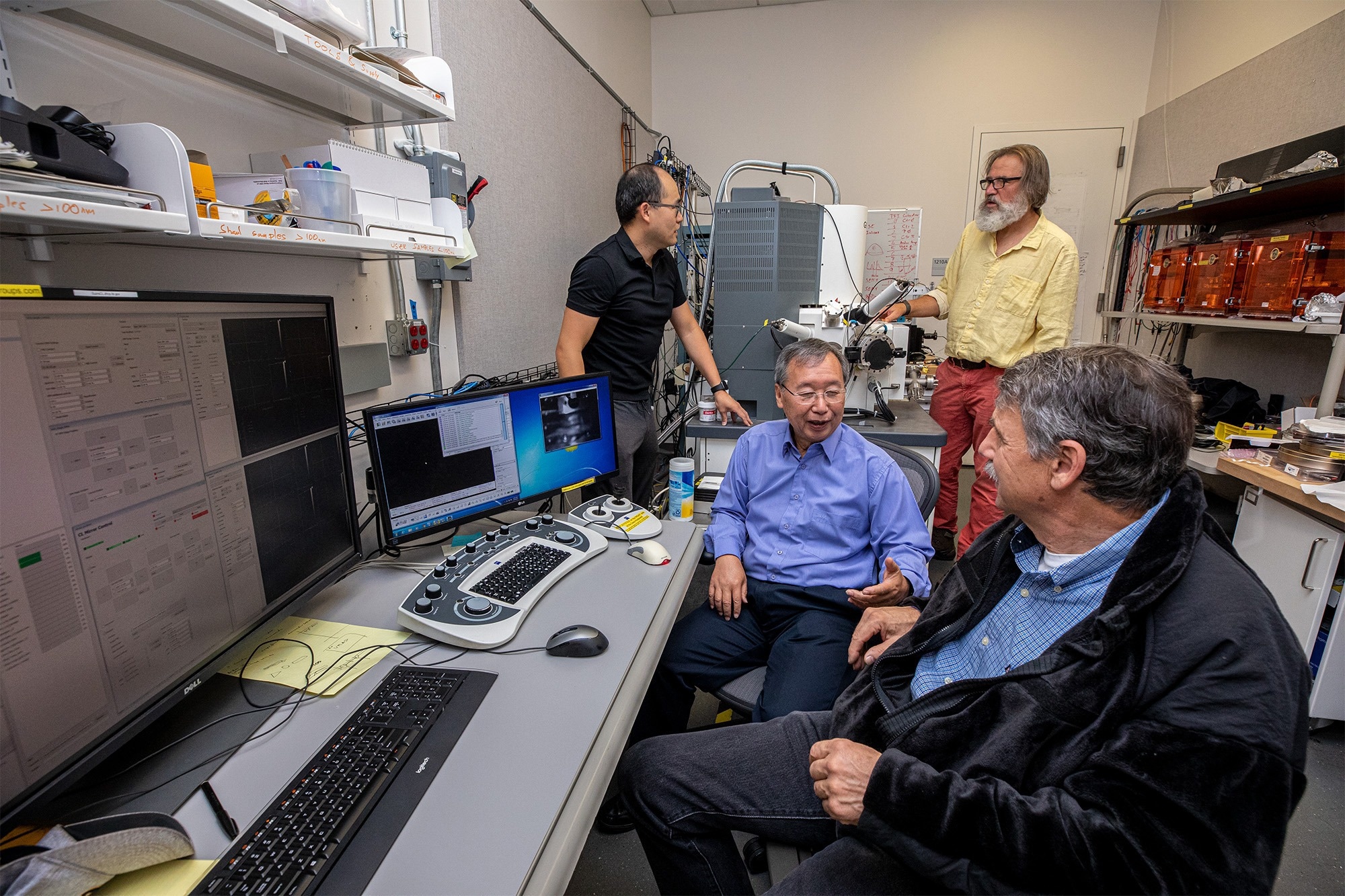Novel devices that can be rapidly swapped between two quantum states are needed to provide scalability in quantum computers, sensors, and networks.

Shaul Aloni, Cong Su, Alex Zettl, and Steven Louie at the Molecular Foundry. The researchers synthesized a device made from twisted layers of hexagonal boron nitride with color centers that can be switched on and off with a simple switch. Image Credit: Marilyn Sargent/Berkeley Lab
Using a solid-state “twisted” crystalline layered material, a team led by scientists from the Lawrence Berkeley National Laboratory (Berkeley Lab) has now devised a technique that produces minute light-emitting points known as color centers. By just applying an external voltage, these color centers can be turned on and off.
This is a first step toward a color center device that engineers could build or adapt into real quantum systems.
Shaul Aloni, Study Co-Lead and Staff Scientist, Molecular Foundry, Lawrence Berkeley National Laboratory
The journal Nature Materials contains a thorough outline of the work.
For instance, the study might result in a new technique for producing quantum bits, or qubits, which are used to encode data in quantum computers.
Color centers are microscopic flaws in crystals like the diamond that, when exposed to a laser or other powerful energy source like an electron beam, typically create intense, stable light of a particular color. They can connect operations across a quantum processor by integration with waveguides, which are light-guiding devices.
Researchers found that color centers in hexagonal boron nitride (hBN), a synthetic material that is frequently used as a lubricant or additive for paints and cosmetics, generate even brighter colors than color centers in diamonds.
However, since it is challenging to produce the flaws at a specific place and because there is currently no dependable method for turning on and off the color centers, engineers have had difficulty using the material in applications.
These issues are now resolved by the Berkeley Lab team. Cong Su, a postdoc in the lab of Alex Zettl, a senior scientist at Berkeley Lab and Professor of Physics at UC Berkeley, investigated the behavior of color centers in various complex configurations of hBN.
The activation and intensification of ultraviolet (UV) emission from a color center, which can be turned off when a voltage is applied across the structure, were discovered to occur in two stacked and twisted layers of the material, according to the researchers.
It is like a sandwich with two pieces of bread, but one rotated relative to the other.
Alex Zettl, Senior Scientist, Lawrence Berkeley National Laboratory
The color centers at the interface are activated and become incredibly bright when the two layers are rotated. Without “unrotating” the halves, the applied voltage adjusts the intensity from bright to entirely dark.
The key to this investigation was Aloni’s creation of a modified electron microscope that could analyze the emitted light in addition to probing the material’s structure.
The arrangement employs an electron beam to activate the color centers. The researchers also discovered that they could use the electron beam to draw patterns onto hBN, like a smiley face, by activating the color centers.
Zettl added, “People typically zap the material with lasers or ions, but we have instead zapped it with a beam of electrons.”
The research makes three advancements in the direction of a scalable quantum device. First, by twisting the crystal contact, the UV color centers in hBN can be consistently activated to exceptional maximum brightness.
Then, by applying a simple voltage, these color centers can be gradually and irreversibly muted. Finally, treatment with an electron beam enables even more accurate spatial positioning of these color centers.
Steven Louie, a distinguished professor of physics at UC Berkeley and a senior faculty scientist at Berkeley Lab, led theoretical calculations that produced candidates for the UV color center atomic configuration to better illustrate why their brightness was dependent on the twist angle.
An excited electron wanders and recombines with a hole in the color center during the light emission process. A typical hBN structure, however, features a lot of traps that might trap the electrons and stop light emission.
Twisting the crystal layers removes many of these traps, or ‘quantum parking lots,’ near the interface.
Steven Louie, Faculty Senior Scientist, Lawrence Berkeley National Laboratory
The team’s next objective is to make samples prepared for atomic characterization so that they can identify the precise atomic structures underlying this mechanism and add more layers of control.
Aloni further added, “The work is pointing us in the direction of new types of mechanisms that we can use to control the emission even better, and this is very important for many applications in quantum information sciences.”
The Molecular Foundry is a Berkeley Lab user facility for the Office of Science.
The DOE Office of Science funded this study.
Journal Reference
Su, C., et al. (2022) Tuning colour centres at a twisted hexagonal boron nitride interface. Nature Materials. doi:10.1038/s41563-022-01303-4.